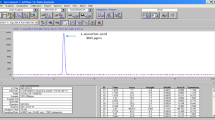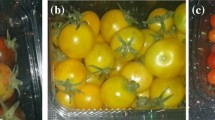Abstract
Non-communicable diseases (NCDs) present a long duration and a slow progression. Good nutrition plays a predominant role in NCD prevention. In Chile, the cultivation of strawberry (Fragaria ananassa) has recently been adapted to volcanic soils with low available phosphorus (P), which can affect the fruit quality in terms of their antioxidant compound content and anti-inflammatory activities. Here, we carried out a study using organic (OF) or chemical (TF) fertilisers at 50 and 100% of the agronomical dose recommendation and without fertilisation (WF) under field conditions. Identification of phenolic compounds was done by HPLC-DAD-ESI-MS/MS, whereas antioxidant activities were determined by spectrophotometric methods. The highest concentrations of anthocyanins and ascorbic acid were obtained in the OF treatments, showing a relationship with the CUPRAC (cupric reducing antioxidant capacity) values. The highest concentrations of total polyphenols were obtained in the TF treatments, according to the TEAC (Trolox equivalent antioxidant capacity), CUPRAC and 2,2-diphenyl-1-picrylhydrazyl tests. The highest enzymatic activities were observed also in the TF treatments. Compared with WF, TF treatment downregulates the cytokine interleukin 10 (IL-10) significantly at a dose of 100%, but we could not show a significantly downregulation yet. Our results suggest that enzymatic antioxidant activity responds better to a period of prolonged exposure to P fertilisation. There is no direct correlation between enzymatic and non-enzymatic antioxidant activity with respect to treatments with different types of P fertilisation.




Similar content being viewed by others
References
Ahmed S, Hussain SB (2009) Ascorbic acid, carotenoids, total phenolic content and antioxidant activity of various genotypes of Brassica oleracea Encephala. CJMB 3:1–8
Alothman M, Bhat R, Karim AA (2009) Antioxidant capacity and phenolic content of selected tropical fruits from Malaysia, extracted with different solvents. Food Chem 115:785–788. https://doi.org/10.1016/j.foodchem.2008.12.005
Alsher GR, Erturk N, Heath SL (2002) Role of superoxide dismutases (SODs) in controlling oxidative stress in plants. J Exp Bot 53:1331–1341. https://doi.org/10.1093/jxb/53.372.1331
Apel K, Hirt H (2004) Reactive oxygen species: metabolism oxidative stress and signal transduction. Annu Rev Plant Biology 55:373–399. https://doi.org/10.1146/annurev.arplant.55.031903.141701
Arena M, Postempsky PD, Curvetto N (2017) Changes in the phenolic compounds and antioxidant capacity of Berberis microphylla G. Forst. berries in relation to light intensity and fertilization. Sci Hortic 218:63–71. https://doi.org/10.1016/j.scienta.2017.02.004
Benavente-García O, Castillo J (2008) Update on uses and properties of citrus flavonoids: new findings in anticancer, cardiovascular, and anti-inflammatory activity. J Agric Food Chem 56:6185–6205. https://doi.org/10.1021/jf8006568
Bernini P, Bertini I, Luchinat C, Tenori L, Tognaccini A (2011) The cardiovascular risk of healthy individuals studied by NMR metabonomics of plasma samples. J Proteome Res 10:4983–4992. https://doi.org/10.1021/pr200452j
Carocho M, Ferreira IC (2013) A review on antioxidants, prooxidants and related controversy: natural and synthetic compounds, screening and analysis methodologies and future perspectives. Food Chem Toxicol 51:15–25. https://doi.org/10.1016/j.fct.2012.09.021
Carvajal DLM, Hadi YE, Cartagena R et al (2012) Antioxidant capacity of two Fragaria x ananassa (Weston) Duchesne (strawberry) varieties subjected to variations in vegetal nutrition. Rev Cubana Plant Med 17:37–53
Cassileth B (2008) Complementary therapies, herbs, and other OTC agents. Oncol 22:1202
Crecente-Campo J, Nunez-Damaceno M, Romero-Rodríguez MA, Vásquez-Oderiza ML (2012) Color, anthocyanin pigment, ascorbic acid and total phenolic compound determination in organic versus conventional strawberries (Fragaria x ananassa Duch, CV Selva). J Food Comp Anal 28:23–30. https://doi.org/10.1016/j.jfca.2012.07.004
Dalmagro AP, Camargo A, da Silva Filho HH et al (2018) Seasonal variation in the antioxidant phytocompounds production from the Morus nigra leaves. Ind Crop Prod 123:323–330. https://doi.org/10.1016/j.indcrop.2018.06.085
Del Rio AL, Sandalio ML, Altomare AD, Zilinskas AB (2003) Mitocondrial and peroxisomal manganese superoxide dismutase: differential expression during leaf senescence. J Exp Bot 54:923–933. https://doi.org/10.1093/jxb/erg091
Donahue JL, Okpodu CM, Cramer CL, Grabau EA, Alscher RG (1997) Responses of antioxidants to paraquat in pea leaves (relationships to resistance). Plant Physiol 113:249–257. https://doi.org/10.1104/pp.113.1.249
Farouk S, Al-Amri SM (2019) Exogenous zinc forms counteract NaCl-induced damage by regulating the antioxidant system, osmotic adjustment substances, and ions in canola (Brassica napus L. cv. Pactol) plants. J Soil Sci 19:887–899. https://doi.org/10.1007/s42729-019-00087-y
Ferreira-Silva SL, Voigt EL, Silva EN et al (2012) Partial oxidative protection by enzymatic and non-enzymatic components an cashew under high salinity. Folia Biol 56:172–176. https://doi.org/10.1007/s10535-011-0156-x
Ghasemnezhad M, Sherafati M, Payvast GA (2011) Variation in phenolic compounds, ascorbic acid and antioxidant activity of five coloured bell pepper (Capsicum annuum) fruits at two different harvest times. J Funct Foods 3:44–49. https://doi.org/10.1016/j.jff.2011.02.002
He Y, Yue Y, Zheng X, Zhang K, Chen S, du Z (2015) Curcumin, inflammation, and chronic disease: how are they linked? Molecules 20:9183–9213. https://doi.org/10.3390/molecules20059183
Iqbal S, Bhanger M (2006) Effect of season and production location on antioxidant activity of Moringa oleifera leaves grown in Pakistan. J Food Compos Anal 19:544–551. https://doi.org/10.1016/j.jfca.2005.05.001
Javanmardi J, Stushnoffb C, Lockeb E, Vivancob JM (2003) Antioxidant activity and total phenolic content of Iranian Ocimum accessions. Food Chem 83:547–550. https://doi.org/10.1016/S0308-8146(03)00151-1
Jin P, Wang SY, Yang CY, Zheng Y (2011) Effect of cultural system and storage temperature on antioxidant capacity and phenolic compounds in strawberries. Food Chem 124:262–270. https://doi.org/10.1016/j.foodchem.2010.06.029
Karousou R, Balta M, Hanlidou E, Kokkini S (2007) Mints, smells and traditional uses in Thessaloniki (Greece) and others Mediterranean countries. J Ethnopharnacol 109:248–257. https://doi.org/10.1016/j.jep.2006.07.022
Kumar V, Abbas AK, Fausto N, Mitchell RN (2012) Robbins basic pathology. Elsevier Health Sciences, Philadephia, PA, USA
Lee DW (2002) Anthocyanins in autumn leaf senescence. Adv Bot Res 37:147–165. https://doi.org/10.1016/S0065-2296(02)37048-4
Lee TC, Shih TH, Huang MY, Lin KH, Huang WD, Yang CM (2018) Eliminating interference by anthocyanins when determining the porphyrin ratio of red plant leaves. J Photochem Photobiol B 187:106–112. https://doi.org/10.1016/j.jphotobiol.2018.08.007
Menon VP, Sudheer AR (2007) Antioxidant and antiinflamatory properties of curcumin. Adv Exp Med Bio 595:105–125. https://doi.org/10.1007/978-0-387-46401-5_3
Montllor-Albalate C, Colin AE, Chandrasekharan B et al (2019) Extra-mitochondrial Cu/Zn superoxide dismutase (SOD1) is dispensable for protection against oxidative stress but mediates peroxide signaling in Saccharomyces cerevisiae. Redox Biol. https://doi.org/10.1016/j.redox.2018.11.022
Mosmann T (1983) Rapid colorimetric assay for cellular growth and survival: application to proliferation and cytotoxicity assays. J Immunol Mehods 65:55–63. https://doi.org/10.1016/0022-1759(83)90303-4
Oboh A (2004) Change in ascorbic acid, total phenol and antioxidant activity of sun dried commonly consumed green leafy vegetables in Nigeria. J Nutrit health 18:29–36. https://doi.org/10.1177/026010600401800103
OMS (2010) Global status report on noncommunicable diseases, 2010 . Ginebra, Suiza. Available: https://www.who.int/nmh/publications/ncd_report2010/en/ [28 March 2019]
Onofrei V, Teliban GC, Burducea M et al (2017) Organic foliar fertilization increases polyphenol content of Calendula officinalis L. Ind Crop Prod 109:509–513. https://doi.org/10.1016/j.indcrop.2017.08.055
Oueslati S, Karray-Bouraoui N, Attia H et al (2010) Physiological and antioxidant res¬ponses of Mentha pulgium (Pennyroyal) to salt stress. Acta Physiol Plant 32:289–296. https://doi.org/10.1007/s11738-009-0406-0
Palma MJ, Jiménez A, Sandalio ML et al (2006) Antioxidative enzymes from chloroplast, mitochondria, and peroxisomes during senescence of nodulated pea plants. J Exp Bot 57:1747–1758. https://doi.org/10.1093/jxb/erj191
Parada J, Valenzuela T, Gomez F et al (2019) Effect of fertilization and arbuscular mycorrhizal fungal inoculation on antioxidant profiles and activities in Fragaria ananassa fruit. J Sci Food Agric 99:1397–1404. https://doi.org/10.1002/jsfa.9316
Polata H, Wiliniska A, Bryjak J, Polakovic M (2009) Thermal inactivation kinetics of vegetable peroxidases. J Food Eng 91:387–391. https://doi.org/10.1016/j.jfoodeng.2008.09.017
Rapisarda P, Blanco IM, Pannuzzo P, Timparo N (2008) Effect of cold five orange genotypes (Citrus sinensis (L.) Osbeck). Postharvest Biol Technol 49:348–354. https://doi.org/10.1016/j.postharvbio.2008.02.002
Ruiz A, Hermosin-Gutierrez I, Vergara C et al (2013) Anthocyanin profiles in south Patagonian wild berries by HPLC-DAD-ESI-MS/MS. Food Res Int 51:706–713. https://doi.org/10.1016/j.foodres.2013.01.043
Ruiz A, Bustamante L, Vergara C, von Baer D, Hermosín-Gutiérrez I, Obando L, Mardones C (2015) Hydroxycinnamic acid and flavonols in native edible berries of South Patagonia. Food Chem 167:84–90. https://doi.org/10.1016/j.foodchem.2014.06.052
Ruiz A, Sanhueza M, Gómez F et al (2019) Changes on the content of anthocyanins, flavonols and antioxidant activity in Fragaria ananassa var. camarosa fruits under traditional and organic fertilization. J Sci Food Agric 99(2019):2404–2010. https://doi.org/10.1002/jsfa.9447
Santos-Buelga C, Scalbert A (2000) Proanthocyanidins and tannin- like compounds: nature, occurrence, dietary intake and effects on nutrition and health. J Sci Food Agric 80:1094–1117. https://doi.org/10.1002/(SICI)1097-0010(20000515)80:7<1094::AID-JSFA569>3.0.CO;2-1
Scandalios JG (1993) Oxygen stress and superoxide dismutases. Plant Physiol 101:7–12. https://doi.org/10.1104/pp.101.1.7
Tavarini S, Degl’Innocenti E, Remorini D, Massai R, Guindi (2008), Antioxidant capacity, ascorbic acid, total phenols and carotenoids changes during harvest and after storage of Hayward kiwifruit. Food Chem 107:282–288. https://doi.org/10.1016/j.foodchem.2007.08.015
Ulloa-Inostroza E, Alberdi M, Ivanov AG, Reyes-Diaz M (2019) Protective effect of methyl jasmonate on photosynthetic performance and its association with antioxidants in contrasting aluminum-resistant blueberry cultivars exposed to aluminum. J Soil Sci 19:203–216. https://doi.org/10.1007/s42729-019-0006-z
Velioglu YS, Mazza G, Gao L, Oomah BD (1998) Antioxidant activity and total phenolic in selected fruits, vegetables, and grain products. J Agric Food Chem 46:4113–4117. https://doi.org/10.1021/jf9801973
Yang J, Paulino R, Janke-Stedronsky S, Abawi F (2007) Free-radical-scavenging activity and total phenols of Noni (Morinda citrifolia L.) juice and powder in processing and storage. Food Chem 10:302–308. https://doi.org/10.1016/j.foodchem.2006.05.020
Yanishlieva NV, Marinova E, Pokorny J (2006) Natural antioxidant from herbs and spices. Eur J Lipid Sci Technol 108:776–793. https://doi.org/10.1002/ejlt.200600127
Zheng W, Wang SY (2001) Antioxidant activity and phenolic compounds in selected herbs. J Agric Food Chem 49:5165–5170. https://doi.org/10.1021/jf010697n
Acknowledgements
The authors would like to thank Dr. Claudia Mardones, Director of the Department of Instrumental Analysis, University of Concepcion, for access to HPLC-DAD-ESI-MS/MS equipment. CG and TE thank Joachim Stärke for excellent technical assistance. We would kindly want to thank the Team of the Blood Donation Centre/Department of Transfusion Medicine of the Städtisches Klinikum Karlsruhe for kindly providing us with the blood samples.
Funding
This study received financial support from the Fondo Nacional de Desarrollo Científico y Tecnológico FONDECYT Grant 11150375. P. Cornejo also received support from FONDECYT Grant 1170264 and CONICYT/FONDAP/15130015.
Author information
Authors and Affiliations
Corresponding author
Ethics declarations
Conflict of Interests
The authors declare that they have no conflicts of interest.
Additional information
Publisher’s note
Springer Nature remains neutral with regard to jurisdictional claims in published maps and institutional affiliations.
Electronic Supplementary Material
ESM 1
(DOCX 50 kb)
Rights and permissions
About this article
Cite this article
Aguilera, A., Tereucán, G., Ercoli, S. et al. Influence of Organic and Chemical Fertilisation on Antioxidant Compounds Profiles and Activities in Fruits of Fragaria ananassa var. Camarosa. J Soil Sci Plant Nutr 20, 715–724 (2020). https://doi.org/10.1007/s42729-019-00159-z
Received:
Accepted:
Published:
Issue Date:
DOI: https://doi.org/10.1007/s42729-019-00159-z




